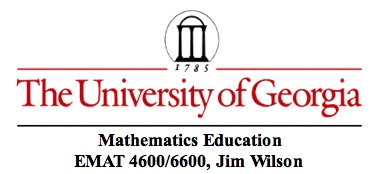

An angle SUBTENDS a line segment when one end of the segment is on each of the legs of the angle.
If we are given an angle and a FIXED line segment XY, then the locus of the vertex is all points where point A can be located. This may be envisioned as moving the fixed angle so that each side slides along on end of the segment.
Physically moving the given angle is not a normal construction and it will help to determine what the locus should be and then develop a construction.
WHY IS THIS AN IMPORTANT CONSTRUCTION?
First, it is useful in accomplishing other constructions. Okay, that is an unsatisfactory answer . . .
Second, it is part of the structure and pattern of the geometry of angles, segments, and circles. If we consider points A, X, and Y,
-- any three points determine a circle.
-- the segment XY is a chord of the the circle and the chord has the same endpoints as the arc.
-- the angle XAY is an inscribed angle of the circle
-- the inscribed angle theorem says that all angles subtending an arc of the circle have measure one-half of the central angle.
Third, the locus underlies ancient and modern navigation technologies. The lighthouse problem allows plotting an observation point (boat) on a map when the angles between light rays of pairs of lighthouses are determine. With only two lighthouses visible, the boat is somewhere along an arc. When three lighthouses are visible, we have two arcs determined and can plot the location of our boat on a map by determining the intersection.
Modern navigation systems such as the Global Positioning System (GPS) is much more sophisticated as three dimensional position is involved rather than two dimensions. Still, the underlying idea is the intersection of surfaces determined by measurements from a set of satellites.
The Problem
Given a fixed angle and a fixed segment, determine the locus of the vertex of the angle as it subtends the segment.
Our problem becomes one of determing how to construct the arc of the circle.
To draw the circle we need to locate its center.
1. The center will lie along the perpendicular bisector of the chord XY.
2. The central angle will be twice the measure of the given angle.
Take the desired figure and see if we can find constructions from the given data -- a given angle and a given line segment.
From the line segment we can readily construct the midpoint and the perpendicular bisector. The center of our circle lines on that bisector.
The central angle is twice the measure of the subtending angle. We do not know where that center is yet so this does not reach a constructible action.
A perpendicular from X or Y would give a line parallel the line through the midpoint. The line from the the center to X would give a transversal of parallel lines.
Since we can construct a perpendiclar from X, we can now copy the given angle in the appropriatle location with one side along that perpendicular and the other side of the angle will intersect the perpendicular bisector of the segment at the center of the circle.
Now, we can do the construction. Begin with the segment XY. Construct the perpediculars from the midpoint and one end. Copy the angle along the end perpendicular and extend the other side to locate the center.
Construct a GSP file and a tool to generate the locus.
Click here for one such file. This one has flaws in the tools construction. We can do better.
This one may be better. Still has flaws.
The "flaws" in these GSP constructions are in the constructions work properly only for "good" data sets. Some input measures will not work properly. Moving the input points slightly may correct most problems.